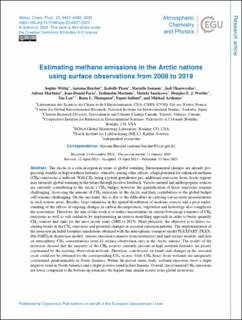| dc.description.abstract | The Arctic is a critical region in terms of global warming. Environmental changes are already progressing steadily in high northern latitudes, whereby, among other effects, a high potential for enhanced methane (CH4) emissions is induced. With CH4 being a potent greenhouse gas, additional emissions from Arctic regions may intensify global warming in the future through positive feedback. Various natural and anthropogenic sources are currently contributing to the Arctic's CH4 budget; however, the quantification of those emissions remains challenging. Assessing the amount of CH4 emissions in the Arctic and their contribution to the global budget still remains challenging. On the one hand, this is due to the difficulties in carrying out accurate measurements in such remote areas. Besides, large variations in the spatial distribution of methane sources and a poor understanding of the effects of ongoing changes in carbon decomposition, vegetation and hydrology also complicate the assessment. Therefore, the aim of this work is to reduce uncertainties in current bottom-up estimates of CH4 emissions as well as soil oxidation by implementing an inverse modelling approach in order to better quantify CH4 sources and sinks for the most recent years (2008 to 2019). More precisely, the objective is to detect occurring trends in the CH4 emissions and potential changes in seasonal emission patterns. The implementation of the inversion included footprint simulations obtained with the atmospheric transport model FLEXPART (FLEXible PARTicle dispersion model), various emission estimates from inventories and land surface models, and data on atmospheric CH4 concentrations from 41 surface observation sites in the Arctic nations. The results of the inversion showed that the majority of the CH4 sources currently present in high northern latitudes are poorly constrained by the existing observation network. Therefore, conclusions on trends and changes in the seasonal cycle could not be obtained for the corresponding CH4 sectors. Only CH4 fluxes from wetlands are adequately constrained, predominantly in North America. Within the period under study, wetland emissions show a slight negative trend in North America and a slight positive trend in East Eurasia. Overall, the estimated CH4 emissions are lower compared to the bottom-up estimates but higher than similar results from global inversions. | en_US |

